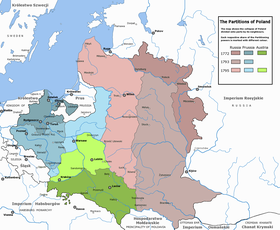Austrian partition
| The Austrian Partition | |
|---|---|
| The Commonwealth | |

The Polish–Lithuanian Commonwealth in 1772
|
|
| Elimination | |

The three partitions of the Polish–Lithuanian Commonwealth. The Russian Partition (Red), the Austrian Partition (green), and the Prussian Partition (blue)
|
The Austrian Partition (Polish: zabór austriacki) comprise the former territories of the Polish–Lithuanian Commonwealth acquired by the Habsburg Monarchy during the Partitions of Poland in the late 18th century. The three partitions were conducted jointly by the Russian Empire, the Kingdom of Prussia and Habsburg Austria, resulting in the complete elimination of the Polish Crown. Austria acquired Polish lands during the First Partition of 1772, and Third Partition of Poland in 1795. In the end, the Austrian sector encompassed the second-largest share of the Commonwealth's population after Russia; over 2.65 million people living on 128,900 km2 (49,800 sq mi) of land constituting formerly south-central part of the Republic.
The territories acquired by Austrian Empire (later the Austro-Hungarian Empire) during the First Partition included the Polish Duchy of Zator and Duchy of Oświęcim, as well as part of Little Poland with the counties of Kraków, Sandomierz and Galicia, less the city of Kraków. In the Third Partition, the annexed lands included Western Galicia and Southern Masovia. Major historical events of the Austrian Partition included: the formation of the Napoleonic Duchy of Warsaw in 1807, which was followed by the 1809 Polish–Austrian War aided by the French, and the victorious Battle of Raszyn resulting in Austrian temporary defeat (1809) marked by the recapture of Kraków and Lwów by the Ducy. However, the fall of Napoleon, leading to abolition of the Duchy at the Congress of Vienna (1815) allowed Austria to regain control. The Congress created the Free City of Kraków protectorate of Austria, Prussia and Russia, which lasted for a decade. It was abolished by Austria, after the crushing of Kraków Uprising in 1846. The formation of the Polish Legions by Piłsudski initially to fight alongside the Austro-Hungarian Army, helped Poland regain its sovereignty in aftermath of World War I.
...
Wikipedia
